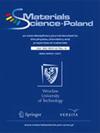生长速率对定向凝固Ti-44Al-9Nb-1Cr-0.2W-0.2Y合金高温拉伸性能和微观组织的影响
IF 1.1
4区 材料科学
Q3 Engineering
引用次数: 0
摘要
本实验采用定向凝固法制备了Ti-44Al-9Nb-1Cr-0.2W-0.2Y合金。研究了不同生长速率对高温拉伸性能和组织取向的影响。制备了三种生长速率分别为10μm/s、15μm/s和20μm/s的合金。结果表明,合金在800℃下的拉伸性能随着生长速率的增加而降低,在组织中的晶内断裂位置发生了再结晶。柱状晶体的尺寸随着生长速率的增加而减小,晶粒数量的增加,生长方向和轴向方向之间的取向差异以及片层的优选取向和材料的各向异性减小,导致拉伸强度和塑性明显降低。结合电子背散射衍射测试结果,研究了三种试样在高温拉伸后有效部位的片层取向。研究发现,随着生长速率的增加,合金试样的轴向择优取向明显降低,随着生长速度的增加,取向变得无序,片层厚度的均匀性逐渐降低。此外,研究发现,高温拉伸后的组织中形成了新的单相γ相,其分布范围随着生长速率的增加而增加,严重降低了合金的轴向择优取向。结果表明,生长速度为10μm/s的定向凝固合金具有较好的组织取向和高温拉伸性能。本文章由计算机程序翻译,如有差异,请以英文原文为准。
Effects of the Growth Rate on the High-temperature Tensile Properties and Micro-organization of Directionally Solidified Ti-44Al-9Nb-1Cr-0.2W-0.2Y Alloys
In this experiment, Ti-44Al-9Nb-1Cr-0.2W-0.2Y alloy was prepared by the directional solidification method. The effect of different growth rates on tensile properties and microstructure orientation at high temperature was studied. Three kinds of alloys with different growth rates of 10 μm/s, 15 μm/s and 20 μm/s were prepared. The results show that the tensile properties of the alloy at 800 ℃ decrease with increasing growth rate, and recrystallization occurred at the position of intracrystal fracture in the microstructure. The size of columnar crystals decreases with the increase of the growth rate, increasing the number of grains and decreasing the orientation difference between the growth and axial directions as well as the preferred orientation of lamellar, and the anisotropy of the material, which leads to the obvious decrease of the tensile strength and plasticity. Combined with electron backscattering diffraction test results, the lamellar orientation of the effective parts of the three specimens after high temperature stretching was studied. It was found that the axial preferred orientation of the alloy specimens decreased obviously with the increase of the growth rate, and the orientation became disorderly and the uniformity of lamellar thickness decreased gradually with the increase of the growth rate. In addition, it was found that a new single-phase γ phase is formed in the microstructure after high temperature stretching, and the distribution range increased with the increase of the growth rate, which seriously degraded the axial preferred orientation of the alloy. It can be concluded that the directionally solidified alloy with a growth rate of 10 μm/s has better microstructure orientation and high temperature tensile properties.
求助全文
通过发布文献求助,成功后即可免费获取论文全文。
去求助
来源期刊

Materials Science-Poland
工程技术-材料科学:综合
CiteScore
1.70
自引率
18.20%
发文量
0
审稿时长
6.2 months
期刊介绍:
Material Sciences-Poland is an interdisciplinary journal devoted to experimental research into results on the relationships between structure, processing, properties, technology, and uses of materials. Original research articles and review can be only submitted.
 求助内容:
求助内容: 应助结果提醒方式:
应助结果提醒方式:


